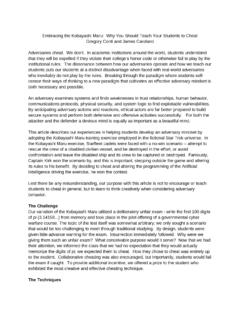Transcription of SYSTEMS THINKING: THE NEW FRONTIER IN …
1 SYSTEMS thinking : THE NEW FRONTIER IN quality management Tito conti , Consultant, Organizational SYSTEMS Fitness Via Saudino, 26 10015 Ivrea, Italy Tel. 0125 616274 email: Summary What happened to quality in the 1980s can be defined, twenty years later, as an unaccomplished revolution . To accomplish it, the dynamic management principles necessary to reach organizational fitness for purpose and keep it over time should be better understood. The paper suggests, as a major factor, the incorporation of modern SYSTEMS thinking concepts into quality management . In such a SYSTEMS perspective, the core issue is the dynamic of value creation and value preservation. To that purpose, the value generation cluster is introduced. A way of revisiting quality management models from the SYSTEMS perspective, in order to make them more effective, is also suggested.
2 Keywords SYSTEMS thinking , organizational architectures, value generation clusters, quality management models, organizational fitness for purpose. INTRODUCTION: THE TQM UNACCOMPLISHED REVOLUTION In the 1980s and early 90s, most top executives of international companies competing in product/market sectors that were hit by the Japanese quality -based competition, became fanatical believers of the new TQM faith. The author, who had the opportunity to be the representative of one of the EFQM s founding companies, still has, before his eyes, the memorable scene of the presidents of fourteen leading European companies sitting on the stage and enthusiastically and competently speaking about their quality -based innovation strategies (EFQM,1988). They did not talk of technology and products, but of changing the organization and the way it used to be managed, to make it better able to face the new challenges.
3 The people who were appointed by such executives as responsible for the new quality strategies were not quality control or quality assurance experts either, but line or staff executives directly reporting to the CEOs. The task that was given them was to help to identify and contribute to the implementation of organizational architectures fit for the quality -based competition. Presidents and CEOs themselves fervently talked about the new style of leadership, delegation and empowerment, process-based flat-and-lean organizations, and the like. Obviously, the most tangible aspects of the new TQM philosophy were the tools that had been developed and successfully applied (like Process management and quality Function Deployment) or those that were re-discovered and re-visited (like SPC). The problem was that, little by little, the tools took the lead, while the organizational transformation that was supposed to be the core of the new management philosophy was postponed, moved to the background and little by little almost forgotten.
4 Only the issue of transforming the vertical, hierarchical organization into a process-based flat organization remained on the agenda of the most advanced companies for a while, but quite often progressively downgraded, due to the difficulty of overcoming resistance to change and finding a satisfactory vertical/horizontal balance. Several were the reasons for the decline of top management interest and consequent degradation of the TQM vision. To name a few: the insistent request for short-term results, which is incompatible with the timescales of serious organizational transformations; the change of top executive priorities, brought in by the so-called new economy and by the frantic pursuit of higher and higher stock value, to the detriment of the real long-term enterprise value. That led to an increasing focus on financial performance (often manipulated), less on sustainable customer/stakeholder value generation capability.
5 Another cause of the decline was the sharp increase in number of quality consultants, attracted by the new business of quality and ready to ride any new fad, instead of educating customers to make the best choices for their companies long-term performance. The result was that, little by little, the companies top executives returned to the old mentality whereby quality is a matter for specialists that does not imply their direct involvement. Those responsible for quality report less and less to the CEO, but it means that they have to have more managerial and organizational expertise. Six Sigma has become the leading approach to quality (in the USA in particular); consultants and academics focus more on packaging and repackaging old stuff instead of continuing the innovation wave that revitalized quality management in the 1980s. A symptom of the decline is the use of the preposition beyond instead of in addition to for promoting a new approach, to make the old obsolete.
6 We even saw approaches claimed to be beyond TQM , simply because the proponent had a narrow view of TQM. Those (this author included) who give the TQM acronym the general meaning of strategic quality management approach aimed at continuous improvement and innovation, do not feel the need to change the name of the toolbox when a new tool comes in. The need to keep organizations fit for purpose and improve fitness over time remains unchanged in fact, even more stringent and more generalized, given the continuous changes in the global environment and the crisis that invests the big worldwide SYSTEMS . A NEW WAVE OF INNOVATION IS NEEDED IN management quality management INCLUDED Technology and statistics alone will not reverse the trend. They are absolutely necessary to meet the product and service objectives and to reduce defects and waste, but, alone, they will not help in surviving competition, let alone reaching excellence and keeping it over time.
7 Since the early times of scientific management , techniques, methods and statistics have been the backbone of western-style management . But they were based on a system model mechanistic that suited the companies status, the social situation and the educational levels of the time. They do not fit the nature of organizations any longer. Even innovation, if pursued just through techniques and tools, will not reverse the trend. Trend reversal will only be achieved by going to the roots of the problem: the way we conceive organizations and, consequently, manage them. It is the assumed mental model of the organization the paradigm - that is no longer adequate. That may sound unpopular, since the idea that progress in technology, techniques and methods is going to solve all our problems is deeply rooted in western mangers DNA. I do not share such a view. I believe in the power of technology in solving technical problems (those related to the mechanistic parts of the system ) and helping solving social problems; but I am also convinced that socio-cultural SYSTEMS , namely organizations, obey a more complex paradigm, where the social part prevails over and in fact conditions the technical part.
8 In a paper presented at the ASQ Conference eight years ago ( conti , 2001), I described the relation between the organizational system and its technical/technological subsystem as that of a cask and the wine it contains. If the cask is unfit to sustain the pressure of the wine, it breaks down. And today s technology wine is ever fermenting, strong, powerful. The cask mainly made of people deserves more attention. In the first decades of the 20th century, the foundations of management were laid by three great innovators, who addressed the problem of making the new large corporations, as well as new state administrations, more efficient. Frederic W. Taylor created what was called scientific management , by using an engineering approach, with emphasis on observation and measurement, which produced enormous improvements in company efficiency. Henry Fayol was a great innovator in the field of administrative management (Fayol, 1949).
9 Both Taylor and Fayol were knowledgeable and creative practitioners, the first an engineer, the second an industrialist, who were able to create, in their minds, reliable models of their contemporary organizations and to build on them rational and effective management models. Max Weber was more a sociologist, with broad knowledge of both industrial and political organizations. His bureaucratic model of management perfectly suited the organizations of its time, Prussian in particular. The management models proposed by these three innovators were at the basis of the dramatic increase in size and efficiency of industry (and public administration) in the first part of the last century. That was because they matched the character of the society of the time and, consequently, of the social organizations that were created in such a society (an example of management paradigms fitting the organizations nature).
10 In time, the new large corporations strongly influenced the surrounding society on one side promoting evolution, on the other causing assimilation crises; and, vice versa, the evolution of society, people s needs, education, strongly influenced the corporations. Mismatch between the organization and the related management models progressively increased, negatively impacting company performance and state of health. We have reached a critical point now, where the mismatch is sometimes dramatic. Not just in companies, but even more in the new very large global organizations that govern trade, finance, energy and supply of critical resources. No wonder that average company life expectancy today, with respect to the lifetimes of long-lived companies, is comparable to that of humankind in the Neanderthal period, with respect to the assumed physiological limits (De Geus, 1997).







